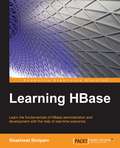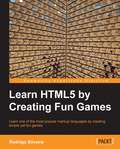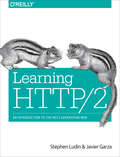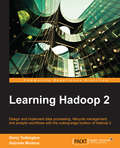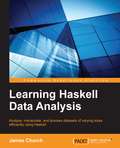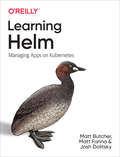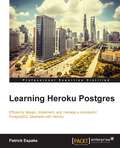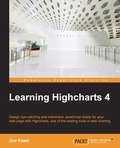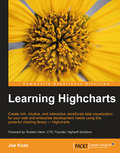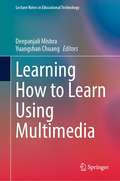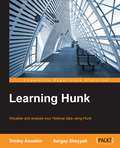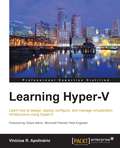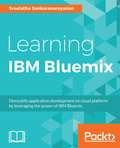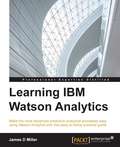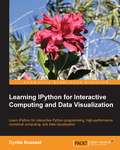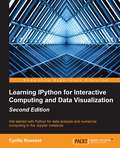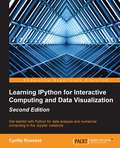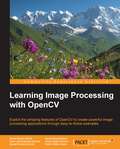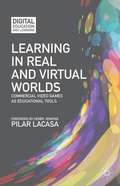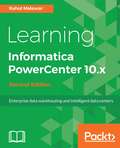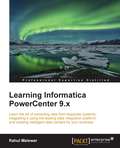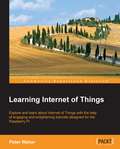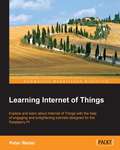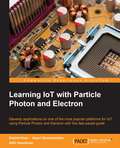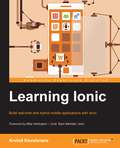- Table View
- List View
Learning HBase
by Shashwat ShriparvIf you are an administrator or developer who wants to enter the world of Big Data and BigTables and would like to learn about HBase, this is the book for you.
Learning HTML5 by Creating Fun Games
by Rodrigo SilveiraBy teaching HTML5 by developing exciting games, the reader will see concrete applications for each of the concepts, and will also have a powerful deliverable at the end of each chapter - a fully functional game. We learn the various concepts using very abstract examples - how to model animals, foods, or fictitious machines. This makes learning and understanding a lot easier, and much more enjoyable.If you are are looking to get a good grounding in how to use the new awesome technology that is HTML5, this book is for you. Basic knowledge of HTML and/or HTML5 is welcome, but optional. The book is a friendly and exciting reference for beginners.
Learning HTTP/2: A Practical Guide for Beginners
by Javier Garza Stephen LudinWhat can your organization gain by adopting HTTP/2? How about faster, simpler, and more robust websites and applications? This practical guide demonstrates how the latest version of the Hypertext Transfer Protocol can dramatically improve website and application performance. You’ll take a deep dive into HTTP/2 details, and learn how this updated protocol is changing the web landscape.HTTP/1.1 has been the primary means of communicating data across the web for the past 20 years, but the level of interaction today has gone well beyond what people envisioned in 1997. With this book, authors Stephen Ludin and Javier Garza show you how HTTP/2 will help speed the execution of modern sites and applications.With this book, you’ll explore:Performance challenges that led to the HTTP upgradeHTTP/2 in a nutshell, including benefits and transition methodsExisting best practices and hacks to improve web performanceHTTP/2 support for browsers, servers, proxies, and content delivery networksHow the performance of sites using HTTP/2 compares to their HTTP/1.1 experienceHTTP/2’s effect on specific issues such as latency, packet loss, and Time to First Byte (TTFB)HTTP/2’s effect on specific issues such as latency, packet loss, and Time to First Byte (TTFB)
Learning Hadoop 2
by Garry Turkington Gabriele ModenaIf you are a system or application developer interested in learning how to solve practical problems using the Hadoop framework, then this book is ideal for you. You are expected to be familiar with the Unix/Linux command-line interface and have some experience with the Java programming language. Familiarity with Hadoop would be a plus.
Learning Haskell Data Analysis
by James ChurchIf you are a developer, analyst, or data scientist who wants to learn data analysis methods using Haskell and its libraries, then this book is for you. Prior experience with Haskell and a basic knowledge of data science will be beneficial.
Learning Helm
by Matt Butcher Matt Farina Josh DolitskyGet up to speed with Helm, the preeminent package manager for the Kubernetes container orchestration system. This practical guide shows you how to efficiently create, install, and manage the applications running inside your containers. Helm maintainers Matt Butcher, Matt Farina, and Josh Dolitsky explain how this package manager fits into the Kubernetes ecosystem and provide an inside look at Helm's design and best practices.More than 70% of the organizations that work with Kubernetes use Helm today. While the Helm community provides thousands of packages, or charts, to help you get started, this book walks developers and DevOps engineers through the process of creating custom charts to package applications. If you have a working understanding of Kubernetes, you're ready to go.Explore primary features including frequently used Helm commandsLearn how to build and deploy Helm charts from scratchUse Helm to manage complexity and achieve repeatable deploymentsPackage an application and its dependencies for easy installationManage the entire lifecycle of applications on KubernetesExplore ways to extend Helm to add features and functionalityLearn features for testing, handling dependencies, and providing security
Learning Heroku Postgres
by Patrick EspakeLearning Heroku Postgres is targeted at developers and database admins. Even if you're new to Heroku Postgres, you'll be able to master both the basic as well as advanced features of Heroku Postgres. Since Heroku Postgres is incredibly user-friendly, no previous experience in computer coding or programming is required.
Learning Highcharts
by Joe KuanA complete practical and comprehensive tutorial with clear and step-by-step instructions along with many examples. It's packed with examples, code samples and practical tips in a no-nonsense way. This book is both for beginners and advanced web developers who need to create interactive charts for their web applications. It primarily targets JavaScript Web developers who want to use the Highcharts library to prepare interactive and professional-quality charts and graphs for their applications quickly and easily. Prior experience with JavaScript is assumed.
Learning Highcharts
by Joe KuanA complete practical and comprehensive tutorial with clear and step-by-step instructions along with many examples. It's packed with examples, code samples and practical tips in a no-nonsense way. This book is both for beginners and advanced web developers who need to create interactive charts for their web applications. It primarily targets JavaScript Web developers who want to use the Highcharts library to prepare interactive and professional-quality charts and graphs for their applications quickly and easily. Prior experience with JavaScript is assumed.
Learning How to Learn Using Multimedia (Lecture Notes in Educational Technology)
by Deepanjali Mishra Yuangshan ChuangThis book introduces the concept of multimedia in education, and how multimedia technology could be implemented to impart digital education to university students. The book emphasizes the versatile use of technology enabled education through the research papers from distinguished academicians and researchers who are specifically working in this area. It benefits all those researchers who are enthusiastic about learning online and also for those academicians who are interested to work on various aspects of learning and teaching through technology.
Learning Hunk
by Dmitry Anoshin Sergey SheypakVisualize and analyze your Hadoop data using Hunk About This Book * Explore your data in Hadoop and NoSQL data stores * Create and optimize your reporting experience with advanced data visualizations and data analytics * A comprehensive developer's guide that helps you create outstanding analytical solutions efficiently Who This Book Is For If you are Hadoop developers who want to build efficient real-time Operation Intelligence Solutions based on Hadoop deployments or various NoSQL data stores using Hunk, this book is for you. Some familiarity with Splunk is assumed. What You Will Learn * Deploy and configure Hunk on top of Cloudera Hadoop * Create and configure Virtual Indexes for datasets * Make your data presentable using the wide variety of data visualization components and knowledge objects * Design a data model using Hunk best practices * Add more flexibility to your analytics solution via extended SDK and custom visualizations * Discover data using MongoDB as a data source * Integrate Hunk with AWS Elastic MapReduce to improve scalability In Detail Hunk is the big data analytics platform that lets you rapidly explore, analyse, and visualize data in Hadoop and NoSQL data stores. It provides a single, fluid user experience, designed to show you insights from your big data without the need for specialized skills, fixed schemas, or months of development. Hunk goes beyond typical data analysis methods and gives you the power to rapidly detect patterns and find anomalies across petabytes of raw data. This book focuses on exploring, analysing, and visualizing big data in Hadoop and NoSQL data stores with this powerful full-featured big data analytics platform. You will begin by learning the Hunk architecture and Hunk Virtual Index before moving on to how to easily analyze and visualize data using Splunk Search Language (SPL). Next you will meet Hunk Apps which can easy integrate with NoSQL data stores such as MongoDB or Sqqrl. You will also discover Hunk knowledge objects, build a semantic layer on top of Hadoop, and explore data using the friendly user-interface of Hunk Pivot. You will connect MongoDB and explore data in the data store. Finally, you will go through report acceleration techniques and analyze data in the AWS Cloud. Style and approach A step-by-step guide starting right from the basics and deep diving into the more advanced and technical aspects of Hunk.
Learning Hyper-V
by Vinicius R. ApolinarioThis book focuses on readers starting their journey with Hyper-V, and assumes they have minimal or no knowledge of virtualization.
Learning IBM Bluemix
by Sreelatha SankaranarayananDemystify application development on cloud platform by leveraging the power of IBM Bluemix About This Book * The first book in the market that discusses the power of IBM Bluemix * Shows developers how to develop and deploy applications on the cloud platform using IBM Bluemix * A comprehensive guide to help you get started with IBM Bluemix also featuring samples applications Who This Book Is For This book is aimed at developers seeking to learn application development and deployment methods on IBM Bluemix. A basic knowledge of Java and Node.js is assumed. What You Will Learn * Discover IBM Bluemix as a PaaS platform and learn about its three delivery models * Develop and deploy a "Hello World" application on IBM Bluemix using the Cloud Foundry command line utility and the Bluemix console * Extend your application by using the API or services provided by IBM Bluemix * Understand microservices architecture and learn how to develop a sample application based on microservices architecture, using IBM Bluemix * Learn how to leverage on-premise software and build an application on IBM Bluemix * Scale and monitor an application on IBM Bluemix * Explore the compute options on IBM Bluemix and work with each of them * Build a mobile client application using Mobile services on IBM Bluemix In Detail IBM Bluemix is an open standard platform for building, running, and managing applications on the cloud. With Bluemix, developers can build innovative applications using various compute options and value added services , developers can also manage the application lifecycle using the platform provided DevOps services. Learning IBM Bluemix will take you on a journey from the basics of IBM Bluemix to working with the platform to developing and deploying of modern applications. The sample application use cases employed in the book will introduce you to the transformative nexus of cloud, mobile, and security, all enabled through capabilities provided out-of-the-box by IBM Bluemix. By the end of the book, you will have understood the benefits and use cases for IBM Bluemix, and will possess the skills to further explore the platform and thus develop, deploy, and secure your own innovative, new-age applications. Style and approach This comprehensive, step-by-step guide to learning IBM Bluemix will cover everything that is required to build, deploy, manage, and secure an application on the cloud.
Learning IBM Watson Analytics
by James D MillerMake the most advanced predictive analytical processes easy using Watson Analytics with this easy-to-follow practical guide About This Book * This is the first and the only book on IBM Watson Analytics, and it shows you how to leverage Watson in an enterprise environment through rich use cases * Incorporate Watson Analytics into your business strategy and confidently add this cutting edge expertise to your resume * This book is written by James D Miller, IBM-certified expert and accomplished Director and Sr. Project Leader Who This Book Is For If you want to perform data discovery and analysis and make sense of data you have, this book for you. Data scientists can also use this book to explore a new way to perform data analysis tasks on cloud with ease. This book does not require a programming background. What You Will Learn * Study the language of Watson while you discover how easy it is to access and configure * Review what a Watson use case is, why it's important, and how to identify one * Design Watson Analytical solutions based upon your use cases * Understand the basic concepts behind the content analysis cycle and where Watson fits in * Explore all the features of Watson, such as Explore, Predict, and Assemble * Customize and extend your Watson solutions * Use Watson at the Enterprise level * Integrate Watson with other toolsets In Detail Today, only a small portion of businesses actually use a real analytical tool as part of routine decision making. IBM Watson Analytics is changing that making the most advanced and predictive analytical techniques understandable and usable for any industry. This book will be the vital tour guide for your trip, starting with what IBM Watson Analytics is. We'll start off with introduction to Watson Analytics and then quickly move on to various use cases under which one can use the different analytics functionalities offered by Watson. During the course of the book, you will learn how to design solutions, and customize and extend Watson analytics. We will conclude by taking Watson Analytics to enterprise and integrating it with other solutions (other IBM solutions and analytics). Now is the time for you to learn IBM Watson to compete in the world. Style and approach Watson provides individuals with the ability to perform sophisticated data discovery and analysis without all of the complexity that usually goes along with it. This book will get you started with Watson analytics and how you can use it in day-to-day data analysis. The book introduces the key concepts and terminology and then uses practical use case examples to reinforce your understanding.
Learning IPython for Interactive Computing and Data Visualization
by Cyrille RossantA practical hands-on guide which focuses on interactive programming, numerical computing, and data analysis with IPython.This book is for Python developers who use Python as a scripting language or for software development, and are interested in learning IPython for increasing their productivity during interactive sessions in the console. Knowledge of Python is required, whereas no knowledge of IPython is necessary.
Learning IPython for Interactive Computing and Data Visualization - Second Edition
by Cyrille RossantGet started with Python for data analysis and numerical computing in the Jupyter notebookAbout This BookLearn the basics of Python in the Jupyter NotebookAnalyze and visualize data with pandas, NumPy, matplotlib, and seabornPerform highly-efficient numerical computations with Numba, Cython, and ipyparallelWho This Book Is ForThis book targets students, teachers, researchers, engineers, analysts, journalists, hobbyists, and all data enthusiasts who are interested in analyzing and visualizing real-world datasets. If you are new to programming and data analysis, this book is exactly for you. If you're already familiar with another language or analysis software, you will also appreciate this introduction to the Python data analysis platform. Finally, there are more technical topics for advanced readers. No prior experience is required; this book contains everything you need to know.What You Will LearnInstall Anaconda and code in Python in the Jupyter NotebookLoad and explore datasets interactivelyPerform complex data manipulations effectively with pandasCreate engaging data visualizations with matplotlib and seabornSimulate mathematical models with NumPyVisualize and process images interactively in the Jupyter Notebook with scikit-imageAccelerate your code with Numba, Cython, and IPython.parallelExtend the Notebook interface with HTML, JavaScript, and D3In DetailPython is a user-friendly and powerful programming language. IPython offers a convenient interface to the language and its analysis libraries, while the Jupyter Notebook is a rich environment well-adapted to data science and visualization. Together, these open source tools are widely used by beginners and experts around the world, and in a huge variety of fields and endeavors.This book is a beginner-friendly guide to the Python data analysis platform. After an introduction to the Python language, IPython, and the Jupyter Notebook, you will learn how to analyze and visualize data on real-world examples, how to create graphical user interfaces for image processing in the Notebook, and how to perform fast numerical computations for scientific simulations with NumPy, Numba, Cython, and ipyparallel. By the end of this book, you will be able to perform in-depth analyses of all sorts of data.Style and approachThis is a hands-on beginner-friendly guide to analyze and visualize data on real-world examples with Python and the Jupyter Notebook.
Learning IPython for Interactive Computing and Data Visualization Second Edition
by Cyrille Rossant<P><P>Get started with Python for data analysis and numerical computing in the Jupyter notebookAbout This BookLearn the basics of Python in the Jupyter NotebookAnalyze and visualize data with pandas, NumPy, matplotlib, and seabornPerform highly-efficient numerical computations with Numba, Cython, and ipyparallelWho This Book Is ForThis book targets students, teachers, researchers, engineers, analysts, journalists, hobbyists, and all data enthusiasts who are interested in analyzing and visualizing real-world datasets. If you are new to programming and data analysis, this book is exactly for you. If you're already familiar with another language or analysis software, you will also appreciate this introduction to the Python data analysis platform. Finally, there are more technical topics for advanced readers. No prior experience is required; this book contains everything you need to know.What You Will LearnInstall Anaconda and code in Python in the Jupyter NotebookLoad and explore datasets inter
Learning Image Processing with OpenCV
by Oscar Deniz Suarez Gloria Bueno GarciaIf you are a competent C++ programmer and want to learn the tricks of image processing with OpenCV, then this book is for you. A basic understanding of image processing is required.
Learning In Real And Virtual Worlds
by Pilar LacasaPacked with critical analysis and real-life examples, this book explores how video games can cultivate learning. Lacasa takes several commercial video games and shows how they can be used both in and out of the classroom to teach initiative and problem-solving, encourage creativity, promote literacy, and develop reasoning skills. The result of almost ten years spent discovering video games, learning to play, conversing with their designers and distributors, and working in the classroom with young people and teachers, Lacasa's work uncovers the educational value already present in commercial video games and shows how to integrate games for learning purposes into the curriculum. It is invaluable for anyone wishing to discover the cultural and educational value of this new form of entertainment in an interdisciplinary environment in which psychology, sociology, art, literature, graphic design, and computer programming are all present.
Learning Informatica PowerCenter 10.x - Second Edition
by Rahul MalewarHarness the power and simplicity of Informatica PowerCenter 10.x to build and manage efficient data management solutions About This Book • Master PowerCenter 10.x components to create, execute, monitor, and schedule ETL processes with a practical approach. • An ideal guide to building the necessary skills and competencies to become an expert Informatica PowerCenter developer. • A comprehensive guide to fetching/transforming and loading huge volumes of data in a very effective way, with reduced resource consumption Who This Book Is For If you wish to deploy Informatica in enterprise environments and build a career in data warehousing, then this book is for you. Whether you are a software developer/analytic professional and are new to Informatica or an experienced user, you will learn all the features of Informatica 10.x. A basic knowledge of programming and data warehouse concepts is essential. What You Will Learn • Install or upgrade the components of the Informatica PowerCenter tool • Work on various aspects of administrative skills and on the various developer Informatica PowerCenter screens such as Designer, Workflow Manager, Workflow Monitor, and Repository Manager. • Get practical hands-on experience of various sections of Informatica PowerCenter, such as navigator, toolbar, workspace, control panel, and so on • Leverage basic and advanced utilities, such as the debugger, target load plan, and incremental aggregation to process data • Implement data warehousing concepts such as schemas and SCDs using Informatica • Migrate various components, such as sources and targets, to another region using the Designer and Repository Manager screens • Enhance code performance using tips such as pushdown optimization and partitioning In Detail Informatica PowerCenter is an industry-leading ETL tool, known for its accelerated data extraction, transformation, and data management strategies. This book will be your quick guide to exploring Informatica PowerCenter's powerful features such as working on sources, targets, transformations, performance optimization, scheduling, deploying for processing, and managing your data at speed. First, you'll learn how to install and configure tools. You will learn to implement various data warehouse and ETL concepts, and use PowerCenter 10.x components to build mappings, tasks, workflows, and so on. You will come across features such as transformations, SCD, XML processing, partitioning, constraint-based loading, Incremental aggregation, and many more. Moreover, you'll also learn to deliver powerful visualizations for data profiling using the advanced monitoring dashboard functionality offered by the new version. Using data transformation technique, performance tuning, and the many new advanced features, this book will help you understand and process data for training or production purposes. The step-by-step approach and adoption of real-time scenarios will guide you through effectively accessing all core functionalities offered by Informatica PowerCenter version 10.x. Style and approach You'll get hand-on with sources, targets, transformations, performance optimization, scheduling, deploying for processing, and managing your data, and learn everything you need to become a proficient Informatica PowerCenter developer.
Learning Informatica PowerCenter 9.x
by Rahul MalewarIf you wish to deploy Informatica in enterprise environments and make a career in data warehousing, then this book is for you. Whether you are a developer who's new to Informatica or an experienced professional, you will learn all the features of Informatica. Basic knowledge of programming and data warehouse concepts is essential.
Learning Internet of Things
by Peter WaherIf you're a developer or electronics engineer who is curious about Internet of Things, then this is the book for you. With only a rudimentary understanding of electronics, Raspberry Pi, or similar credit-card sized computers, and some programming experience using managed code such as C# or Java, you will be taught to develop state-of-the-art solutions for Internet of Things in an instant.
Learning Internet of Things
by Peter Waher<P><P>Explore and learn about Internet of Things with the help of engaging and enlightening tutorials designed for Raspberry Pi <P><P>About This Book <P><P>Design and implement state-of-the-art solutions for Internet of Things using different communication protocols, patterns, C# and Raspberry Pi <P><P>Learn the capabilities and differences between popular protocols and communication patterns and how they can be used, and should not be used, to create secure and interoperable services and things A step-by-step hands-on tutorial with complete source code, that provides interoperable solutions for sensors, actuators, controllers, cameras, and protocol brides <P><P>Who This Book Is For <P><P>If you're a developer or electronics engineer who is curious about Internet of Things, then this is the book for you. With only a rudimentary understanding of electronics, Raspberry Pi, or similar credit-card sized computers, and some programming experience using managed code such as C# or Java, you will be taught to develop state-of-the-art solutions for Internet of Things in an instant. <P><P>What You Will Learn <P><P>Know the capabilities and limitations of the HTTP, UPnP, CoAP, MQTT, and XMPP protocols <P><P>Use important communication patterns, such as the request/respond, publish/subscribe, event subscription, asynchronous messaging, and multicasting patterns <P><P>Secure the life cycle of Things on the Internet by using Thing registries and delegation of trust <P><P>Decrease complexity and development time by using Internet of <P><P>Things service platforms <P><P>Understand basic threats on the Internet and implement effective counter measures <P><P>Combine interoperability and security to create open yet secure solutions <P><P>Implement secure, scalable, decentralized, and interoperable architectures and solutions for Internet of Things <P><P>In Detail <P><P>This book starts by exploring the popular HTTP, UPnP, CoAP, MQTT, and XMPP protocols. You will learn how protocols and patterns can put limitations on network topology and how they affect the direction of communication and the use of firewalls. Thing registries and delegation of trust are introduced as important tools to secure the life cycle of Things on the Internet. Once the fundamentals have been mastered, your focus will move to the Internet of Things architecture. A secure architecture is proposed that will take full advantage of the power of Internet of Things and at the same time protect end user integrity and private personal data without losing flexibility and interoperability. <P><P>This book provides you with a practical overview of the existing protocols, communication patterns, architectures, and security issues important to Internet of Things.
Learning IoT with Particle Core and Photon
by Rashid KhanThis book is for developers, IoT enthusiasts, and hobbyists who want to enhance their knowledge of IoT machine-to-machine architecture using Particle Photon and Electron, and implement cloud-based IoT projects.
Learning Ionic
by Arvind RavulavaruThis book is intended for those who want to learn how to build hybrid mobile applications using Ionic. It is also ideal for people who want to explore theming for Ionic apps. Prior knowledge of AngularJS is essential to complete this book successfully.
